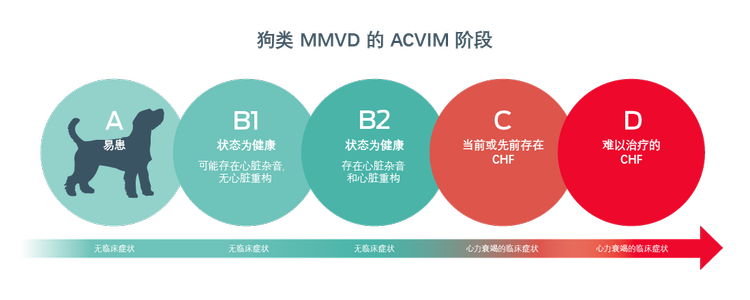
心血管疾病
粘液瘤性二尖瓣疾病 (MMVD) 的饮食管理
粘液瘤性二尖瓣疾病 (MMVD) 是最�常见的犬科心脏病。当前的营养指南侧重于在犬只表现出心脏变化迹象之后提出相关建议。但新的研究表明,在犬只出现心力衰竭症状之前,含有多种营养素的心脏保健混合物 (CPB) 有助于改善早期 MMVD 患犬的心脏功能并减缓疾病进展。


重要信息
- 粘液瘤性二尖瓣疾病 (MMVD) 是最常见的后天性犬科心脏病。1-3
- 在北美,MMVD 约占犬科心脏病的 75%。1
- 大多数患犬是体重不足 20 公斤的老年小型犬,但大型犬也可能罹患 MMVD。1,4

- 在发展到疾病后期阶段之前,MMVD 患犬通常看起来很健康。但是,即使在这一临床前阶段,在患犬体内,心脏也已经开始发生病变。1
- MMVD 是一种进展缓慢的疾病,但进展速度难以预测。1
- 大约有 30% 的 MMVD 患犬会发展为晚期心脏病。2,5
- 当前的营养建议主要侧重于在充血性心力衰竭发生后管理相关症状,但新的研究表明,含有多种营养素的心脏保健混合物 (CPB) 有助于改善早期 MMVD 患犬的心脏功能并减缓疾病进展。1,6,7
- 一项为期 6 个月的饮食研究表明,在以全面均衡的饮食喂养 CPB 的早期 MMVD 患犬中,多项关键心脏指标具有临床获益。6
- 超过 1/3 采用对照饮食的患犬从 B1 进展为 B2;喂养 CPB 的患犬则未出现进展。
- 喂养对照饮食的患犬的左心房大小平均增加 10%;喂养 CPB 的患犬的左心房大小平均减少 3%。
- 25% 喂养对照饮食的患犬的二尖瓣反流严重程度恶化,但喂养 CPB 的患犬中仅有 10% 出现恶化,另有 30% 得到改善。
- 代谢组学研究表明,喂养 CPB 的患犬的临床获益与分子水平的积极变化存在关联。7,8


与宠物主人分享:
参考文献
- Keene, B. W., Atkins, C. E., Bonagura, J. D., Fox, P. R., Häggström, J., Fuentes, V. L., Oyama, M. A., Rush, J. E., Stepien, R., & Uechi, M. (2019). ACVIM consensus guidelines for the diagnosis and treatment of myxomatous mitral valve disease in dogs. Journal of Veterinary Internal Medicine, 33(3), 1127–1140.
- Borgarelli, M., Crosara, S., Lamb, K., Savarino, P., La Rosa, G., Tarducci, A., & Häggström, J. (2012). Survival characteristics and prognostic variables of dogs with preclinical chronic degenerative mitral valve disease attributable to myxomatous degeneration. Journal of Veterinary Internal Medicine, 26(1), 69–75. doi: 10.1111/j.1939-1676.2011.00860.x.
- Buchanan, J. W. (1977). Chronic valvular disease (endocardiosis) in dogs. Advances in Veterinary Science, 21, 57–106.
- Parker, H. G., & Kilroy-Glynn, P. (2012). Myxomatous mitral valve disease in dogs: Does size matter? Journal of Veterinary Cardiology, 14(1), 19–29. doi:10.1016/j.jvc.2012.01.006
- Borgarelli, M., & Häggström, J. (2010). Canine degenerative myxomatous mitral valve disease: Natural history, clinical presentation and therapy. Veterinary Clinics of North America: Small Animal Practice, 40, 651–663.
- Li, Q., Heaney, A., Langenfeld-McCoy, N., Boler, B. V., & Laflamme, D. P. (2019). Dietary intervention reduces left atrial enlargement in dogs with early preclinical myxomatous mitral valve disease: A blinded randomized controlled study in 36 dogs. BMC Veterinary Research, 15(1), 425. doi: 10.1186/s12917-019-2169-1
- Li, Q., Laflamme, D. P., & Bauer, J. E. (2020). Serum untargeted metabolomic changes in response to diet intervention in dogs with preclinical myxomatous mitral valve disease. PloS One, 15(6), e0234404. doi: 10.1371/journal.pone.0234404
- Li, Q., Larouche-Lebel, E., Loughran, K. A., Huh, T. P., Suchodolski, J. S., & Oyama, M. A. (2021). Metabolomics profiling analysis reveals deranged energy metabolism and amino acid metabolic reprogramming in dogs with myxomatous mitral valve disease. Journal of the American Heart Association, 10(9), e018923. doi: 10.1161/JAHA.120.018923.